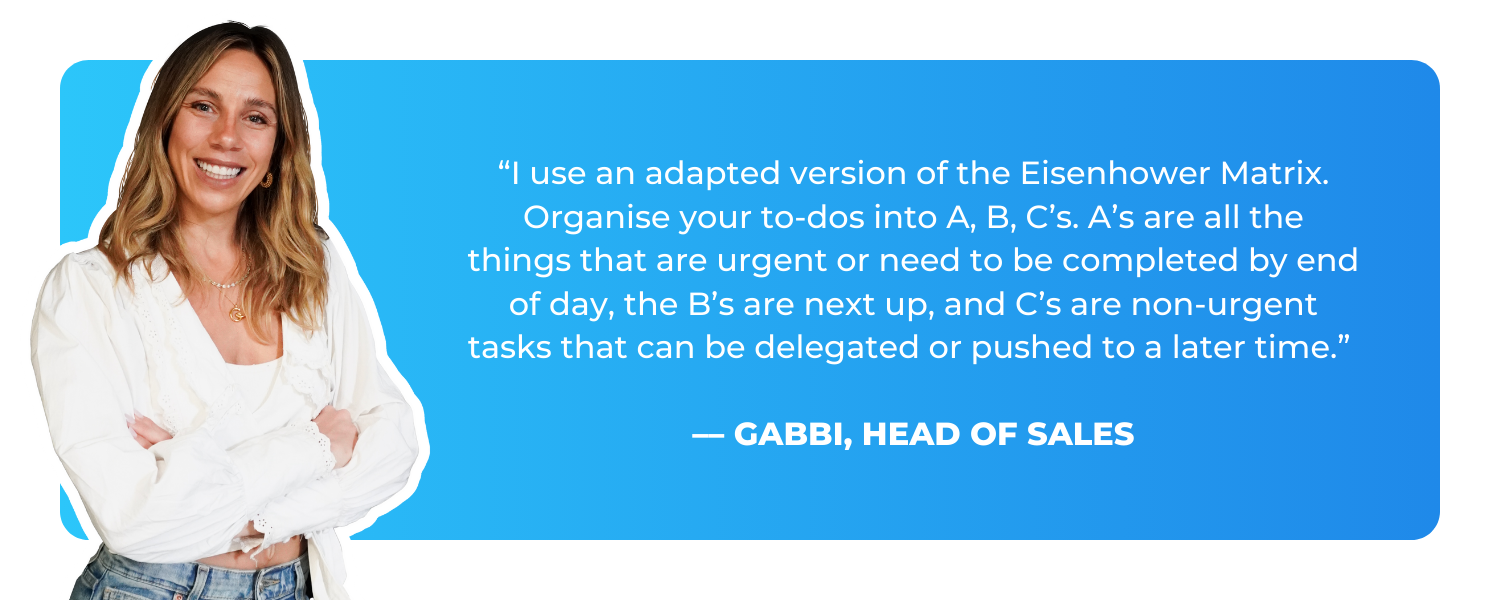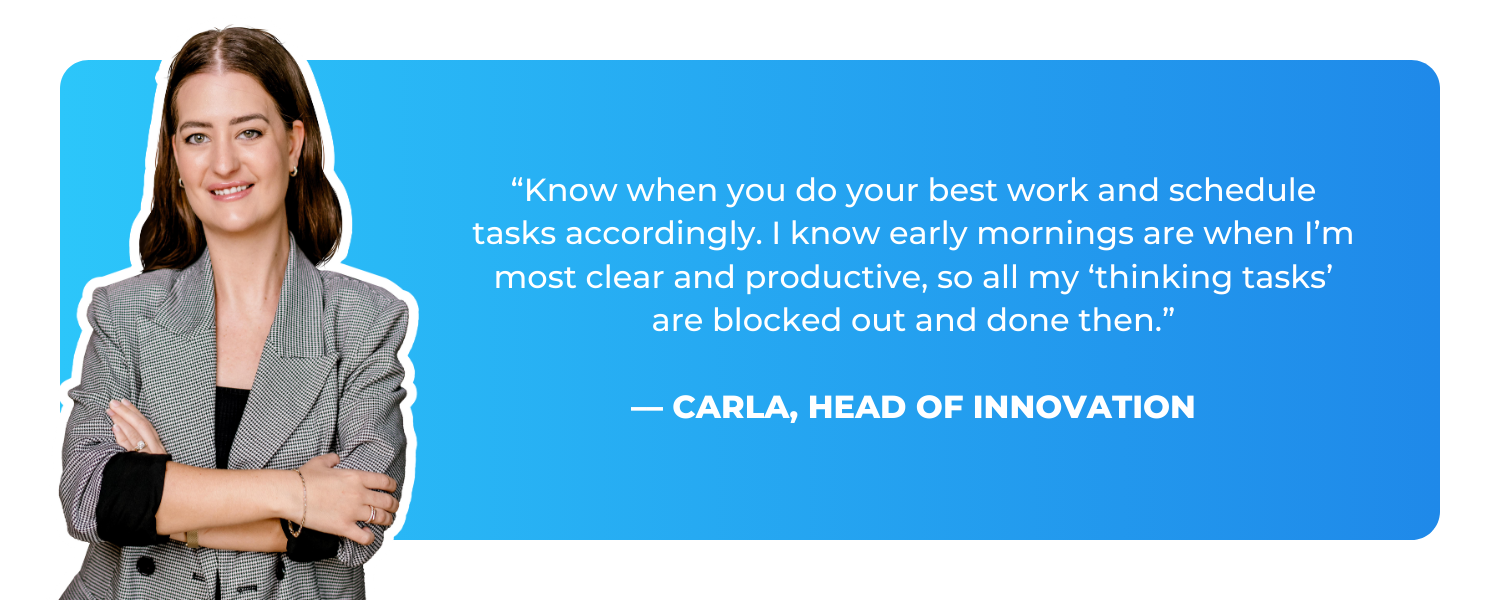Ever felt like there just aren’t enough hours in the day? Like that to-do list keeps on growing, and even though you’re always busy, you rarely get anything done.
It’s an all too common struggle for business owners, entrepreneurs, and busy professionals. You’re juggling multiple roles and responsibilities at once, navigating frequent interruptions and constantly switching between tasks. And you know what? This multitasking is actually squashing your productivity by as much as 40%!
Yep, trying to do multiple things at once (or being pulled out of deep work by notifications, emails, and Slack messages) increases your cognitive load and reduces the quality of your work. You know how your computer slows down when you have 27 different apps and tabs open at once? The same thing happens in your brain.
So, what can you do to hack your productivity, manage your time more effectively, and get more out of your day (while increasing the quality of your output)? Let’s talk about it.
(Plus, some of the Five by Five team shares their top tips for time management and navigating a varied workload).
At Five by Five, we’re all about helping you share your magic through conversion-focused website design and high-impact digital marketing solutions. Whether you’re a new business in need of a wow-worthy digital launch, or an established business looking to refresh and replace your old site, we have the know-how and dedication to make it happen. Contact us today to get started.
Strategies for prioritising your workload
Avoid procrastination by eating the frog
As a small business owner, it can seem like everything on your plate is urgent, important, and needing your attention. Hence, the overwhelm (right??). But while it might seem that way, it’s important to learn how to identify and prioritise the tasks that are truly essential and will move your business forward.
Most people fall into the trap of tackling easier, less important tasks first, thinking they can quickly tick them off their to-do list and move on to the bigger items. We’ve definitely been guilty of this, and you probably have too! The thing is, this can lead to a false sense of productivity – acting as busywork for you while the crucial tasks remain unattended.
Instead, eat the frog.
Start your day by identifying the biggest, toughest and/or most important task and do that first. This should be the one thing that will have the most significant impact on your business or bring you closer to your goals. Focus on completing this task before you look at or work on anything else, and you’ll build momentum for your day knowing that the most important item on your to-do list has been ticked off!
Prioritise effectively with an Eisenhower Matrix
The Eisenhower Matrix is a simple yet powerful tool for managing your time and prioritising tasks based on urgency and importance. It divides your tasks into four quadrants.

Urgent and important (do first)
These tasks require immediate attention and are critical to either operating your business and/or achieving your goals. For example, finishing a client proposal, sending off an invoice for payment, meeting a project deadline, etc. Completing these tasks helps prevent last-minute rushes and stress.
Important but not urgent (schedule)
Consider here the tasks and projects that are essential for long-term success but don’t require immediate action. For example, strategic planning, relationship building or networking, market research, etc. Scheduling time into your calendar for these activities ensures you are making consistent progress towards your goals, and prevents your time from being consumed by all those urgent items that pop up throughout the day/week.
Urgent but not important (delegate)
These tasks require immediate attention but do not require your specific skill set and/or are not essential to your overall business objectives. What does this mean? You can delegate them! This might include team meetings that don’t require your direct input, editing photo or video content, formatting client documents, uploading blog posts, etc. If they can be actioned by someone else, get them off your to-do list so you can focus on the bigger items. If you don’t have the option of delegating, we suggest blocking off some time in the afternoon to action these when your energy and focus dips – that way, you can save your most productive time for deeper and more important work!
Not urgent and not important (delete)
These tasks aren’t time-sensitive OR essential. For example, organising your inbox rather than answering emails, scrolling social media, or filming TikToks when you know your audience connects with you via email and Linked In. Ask yourself (honestly) whether these things are the best use of your time, and if not, get rid of them so you can focus on more meaningful work.
Categorising your tasks this way can really transform how you approach your daily workload, helping you to work smarter (not just harder) and dedicate more of your time towards the tasks and projects that contribute to your long-term goals.

Maximise results with the 80/20 Rule
The 80/20 Rule, or Pareto Principle, states that 80% of your results come from 20% of your efforts. If you want to maximise your results, review your tasks and identify the 20% that will contribute to 80% of your desired outcomes. Focus on these high-impact tasks first, as they are the most valuable and will actively drive your success.
On the flip side of this, what are the tasks that fall into the 80% of efforts yielding only 20% of the results? These tasks are often less critical and can be delegated or eliminated to free up time for more important activities (perhaps falling into that ‘urgent but not important’ quadrant from above).
Let’s see what this looks like in action.
John, an accountant, applies the Pareto Principle to prioritise his workload by identifying the tasks that generate the most value for his business. He reviews his client list and realises that 80% of his revenue comes from 20% of his clients. So, he prioritises delivering exceptional service to these high-value clients, upselling additional services, and creating targeted marketing campaigns to attract a similar clientele. John also analyses his service offerings and finds that financial planning and tax advisory services are the most profitable in his business, making up 80% of his revenue while taking up only 20% of his time. To maximise his productivity, John delegates routine administrative duties and minor bookkeeping tasks to his team, and focuses on delivering more of these high-impact services.
This approach not only boosts efficiency but also helps you achieve your business goals faster. Regularly review your activities to ensure you’re focusing on the most productive tasks, and adjust your priorities as needed.
Techniques for effective time management
Manage your calendar by time blocking
Time blocking is a game-changer for managing your schedule and staying focused. This technique involves dividing your day into segments, or blocking out chunks of time on your calendar each day/week/month, with each block dedicated to a particular task or group of tasks. No more bouncing from one task to another — time blocking helps you stay focused and productive.
One of the key benefits of time blocking is that it reduces the cognitive load associated with constantly switching between tasks. When you know exactly what you should be working on at any given moment, you can dive deep into the task without distractions and prevent the overwhelm that comes from feeling disorganised or overloaded.
Start by identifying your most important tasks and assigning them dedicated time blocks. Instead of getting distracted by emails and notifications throughout the day, schedule a few 15 minute blocks in the morning and/or afternoon to check and reply to these instead. Include breaks and buffer times to handle unexpected interruptions. Over time, you’ll be able to identify patterns in your workload and schedule (eg. lots of last minute things coming up on a Monday afternoon), and tweak/refine your time blocks and buffers accordingly (eg. adding a bigger buffer for interruptions on Mondays). Better productivity, better time management, less stress. That’s a win!

Stay focused with the Pomodoro Technique
The Pomodoro Technique is another powerful method for maintaining focus and productivity. This technique involves working in focused 25-minute intervals (called Pomodoros), followed by a short 5-minute break. After completing four Pomodoros, take a longer break of 15-30 minutes. This method keeps your mind fresh and helps you maintain concentration throughout the day.
The beauty of the Pomodoro Technique lies in its simplicity and effectiveness. By breaking your work into manageable chunks, you avoid burnout and maintain concentration during dedicated work times. The short breaks allow you to recharge, while the longer breaks provide an opportunity to relax and reset. This technique is especially useful for tackling large projects or tasks that require sustained attention. Give it a try, and you might be surprised at how much you can accomplish in just a few Pomodoros.
Avoid overwhelm with The Two-Minute Rule
The Two-Minute Rule is a simple yet effective strategy for managing small tasks efficiently. If a task takes two minutes or less to complete, do it immediately. That’s it!
Why is this great? It prevents minor tasks from piling up and overwhelming your schedule, and helps you to avoid procrastination with an action-oriented mindset.
Applying the Two-Minute Rule is particularly useful for handling things like emails, quick phone calls, or minor administrative tasks. By taking immediate action on these small items instead of adding to your to-do list, you save time in the long run and free up more mental energy for deep work.

Don’t feel like you need to implement all of these — this will just add to the overwhelm! We recommend choosing one or two techniques that resonate most with you, adapting them as needed to suit your specific role and responsibilities, and then integrating these into your schedule gradually.
Start small by committing to tackling your biggest task first each day, and blocking out time in your calendar for recurring tasks, for example. Over time, as you become comfortable with these new habits, you can explore additional tools and techniques.
Remember, productivity isn’t about working harder — it’s about working smarter. Be intentional and strategic as you consider integrating these productivity boosters, and you’ll find yourself more organised, less stressed, and well on track to achieving your goals!
Five by Five is your digital partner, helping you share your magic and scale your business with conversion-focused web design and high-impact digital marketing solutions.
As a business owner, trying to understand all the moving parts of a high-impact digital marketing strategy while also running your business is no small feat. If you need support creating and managing your content strategy, we’re here to take some of the stress off your plate, get you seriously awesome results, and support you with your business growth.
Contact us today to chat with one of our digital strategists about how we can help you achieve your business goals.




